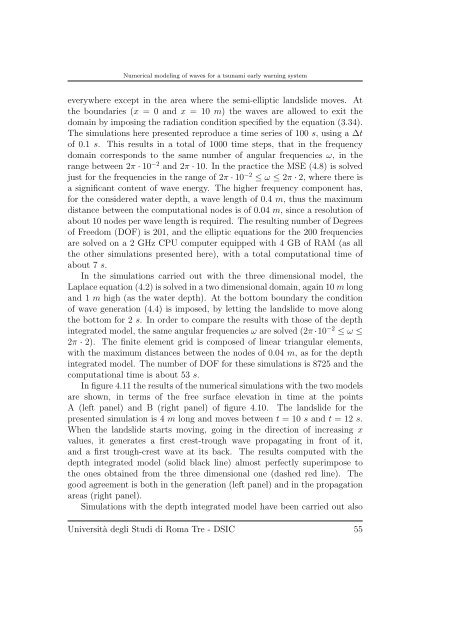Numerical modeling of waves for a tsunami early warning system
Numerical modeling of waves for a tsunami early warning system
Numerical modeling of waves for a tsunami early warning system
You also want an ePaper? Increase the reach of your titles
YUMPU automatically turns print PDFs into web optimized ePapers that Google loves.
<strong>Numerical</strong> <strong>modeling</strong> <strong>of</strong> <strong>waves</strong> <strong>for</strong> a <strong>tsunami</strong> <strong>early</strong> <strong>warning</strong> <strong>system</strong><br />
everywhere except in the area where the semi-elliptic landslide moves. At<br />
the boundaries (x =0andx =10m) the <strong>waves</strong> are allowed to exit the<br />
domain by imposing the radiation condition specified by the equation (3.34).<br />
The simulations here presented reproduce a time series <strong>of</strong> 100 s, usingaΔt<br />
<strong>of</strong> 0.1 s. This results in a total <strong>of</strong> 1000 time steps, that in the frequency<br />
domain corresponds to the same number <strong>of</strong> angular frequencies ω, inthe<br />
range between 2π · 10 −2 and 2π · 10. In the practice the MSE (4.8) is solved<br />
just <strong>for</strong> the frequencies in the range <strong>of</strong> 2π · 10 −2 ≤ ω ≤ 2π · 2, where there is<br />
a significant content <strong>of</strong> wave energy. The higher frequency component has,<br />
<strong>for</strong> the considered water depth, a wave length <strong>of</strong> 0.4 m, thusthemaximum<br />
distance between the computational nodes is <strong>of</strong> 0.04 m, since a resolution <strong>of</strong><br />
about 10 nodes per wave length is required. The resulting number <strong>of</strong> Degrees<br />
<strong>of</strong> Freedom (DOF) is 201, and the elliptic equations <strong>for</strong> the 200 frequencies<br />
are solved on a 2 GHz CPU computer equipped with 4 GB <strong>of</strong> RAM (as all<br />
the other simulations presented here), with a total computational time <strong>of</strong><br />
about 7 s.<br />
In the simulations carried out with the three dimensional model, the<br />
Laplace equation (4.2) is solved in a two dimensional domain, again 10 m long<br />
and 1 m high (as the water depth). At the bottom boundary the condition<br />
<strong>of</strong> wave generation (4.4) is imposed, by letting the landslide to move along<br />
the bottom <strong>for</strong> 2 s. In order to compare the results with those <strong>of</strong> the depth<br />
integrated model, the same angular frequencies ω are solved (2π ·10 −2 ≤ ω ≤<br />
2π · 2). The finite element grid is composed <strong>of</strong> linear triangular elements,<br />
with the maximum distances between the nodes <strong>of</strong> 0.04 m, as<strong>for</strong>thedepth<br />
integrated model. The number <strong>of</strong> DOF <strong>for</strong> these simulations is 8725 and the<br />
computational time is about 53 s.<br />
In figure 4.11 the results <strong>of</strong> the numerical simulations with the two models<br />
are shown, in terms <strong>of</strong> the free surface elevation in time at the points<br />
A (left panel) and B (right panel) <strong>of</strong> figure 4.10. The landslide <strong>for</strong> the<br />
presented simulation is 4 m long and moves between t =10s and t =12s.<br />
When the landslide starts moving, going in the direction <strong>of</strong> increasing x<br />
values, it generates a first crest-trough wave propagating in front <strong>of</strong> it,<br />
and a first trough-crest wave at its back. The results computed with the<br />
depth integrated model (solid black line) almost perfectly superimpose to<br />
the ones obtained from the three dimensional one (dashed red line). The<br />
good agreement is both in the generation (left panel) and in the propagation<br />
areas (right panel).<br />
Simulations with the depth integrated model have been carried out also<br />
Università degli Studi di Roma Tre - DSIC 55

















